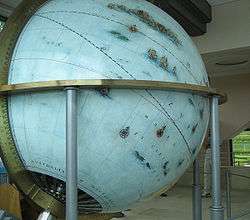Globe of Gottorf
The Globe of Gottorf (German: Gottorper Globus or Gottorfer Globus, Danish: Den gottorpske kæmpeglobus or Gottorpsk kæmpeglobus) is a 17th-century large globe of the earth in the Kunstkamera museum in St. Petersburg in Russia. It measures 3.1 meters in diameter.

The globe details a map of the earth’s surface on the outside and a map of star constellations with astrological and mythological symbols on the inside. Turned by water power, it demonstrates the “movement” of the heavens to those seated inside in candlelight. It was a predecessor of the modern planetarium.
Spelling
Modern German spells the name of Gottor(p) with an F, not a P
Origins
The original globe was built between 1654 to 1664 in Gottorf on request of Frederick III, Duke of Holstein-Gottorp.
Construction was carried out under the supervision of Adam Olearius and completed by Andreas Bösch,[1] both the residents of the Duke. It was put in a palace garden to amuse and amaze visitors.
Transport to Russia
The globe was given to Peter the Great during the Great Northern War and brought to St. Petersburg on March 20, 1717.
Initially, it was placed in a special pavilion on the Tsaristin meadow (now the Field of Mars). It is known that the Tsar frequently examined the Gottorf globe in the morning, such was the interest he took in it.
In 1717, the globe was moved to the tower of the Kunstkamera building.
Destruction by fire
It was severely damaged in a fire in 1747, and its surface was destroyed.
Elizabeth of Russia had the globe rebuilt, but strictly speaking it was no more than a replica since not much was left after the fire. It was built and painted anew using the original wooden ribs.
Temporary return to Germany
The Germans seized the globe at the Dutch Admiralty (where it had been exhibited since 1901) during the Second World War, but it was returned to Russia in 1947.
Present status
The original globe now resides in the Kunstkamera, a museum in St. Petersburg.
German charitable foundations agreed to build a near-replica of the globe in the 1990s, but this time in steel, with electric motors and lights, and install it at Gottorf Castle.
References
- Ley, Willy (February 1965). "Forerunners of the Planetarium". For Your Information. Galaxy Science Fiction. pp. 87–98.